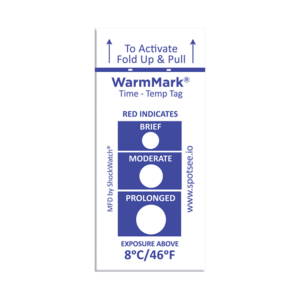The Cost-Effective Solution: SpotSee’s WarmMark 8°C/46°F
SpotSee’s WarmMark 8°C/46°F is the cost-effective solution for compounding pharmacists shipping GLP-1 prescriptions. This reliable temperature monitor ensures medication efficacy and patient safety with real-time alerts for any temperature excursions, preventing costly spoilage and waste. Affordable and easy to use, WarmMark helps maintain compliance and quality in pharmaceutical shipments.
Best Practices for Shipping GLP-1 Receptor Agonists
- Temperature Control:
- Cold Chain Management: Utilize insulated shipping containers with gel packs or cold packs to maintain the medication at the required temperature range (typically between 2°C and 8°C).
- Temperature Monitors: The WarmMark 8°C from SpotSee is an optimal choice for monitoring temperature during transport. This reliable indicator provides clear and immediate visual indication if the temperature exceeds 8°C, ensuring that any excursions are easily identified.
- Packaging:
- Insulated Containers: Choose high-quality insulated boxes designed specifically for pharmaceuticals.
- Proper Cushioning: Securely pack the medication to prevent damage during transit.
- Shipping Method:
- Overnight or Expedited Shipping: Select reliable courier services that offer expedited shipping to minimize transit time.
- Trackable Shipping: Ensure the service provides tracking capabilities for both the pharmacy and the patient.
- Compliance and Documentation:
- Labeling: Clearly label packages with instructions like “Refrigerate Upon Arrival” and any necessary handling guidelines.
- Documentation: Include all required paperwork, such as prescription details, patient information, and storage instructions.
- Communication:
- Notify the Patient: Inform patients about shipment details, including the delivery date and special handling instructions.
- Follow-up: Check in with patients after delivery to confirm receipt and proper storage of the medication.
Regulatory Standards and Guidelines
Adhering to regulatory standards is crucial for compliance and ensuring the quality of the medications you ship. The following are key regulatory frameworks and guidelines to follow:
- U.S. Pharmacopeia (USP) Standards:
- USP <1079>: Guidelines for Good Storage and Distribution Practices for Drug Products.
- USP <797>: Standards for Pharmaceutical Compounding – Sterile Preparations.
- Food and Drug Administration (FDA):
- GMP Guidelines: Ensure quality is maintained throughout the product’s shelf life, including during shipping.
- Temperature-Controlled Logistics Guidance: Detailed requirements for maintaining proper temperature control during storage and transportation.
- State Regulations:
- Board of Pharmacy Regulations: Compliance with state-specific regulations regarding the shipping and handling of prescription medications, including compounded drugs.
- International Air Transport Association (IATA) Guidelines:
- Perishable Cargo Regulations (PCR): Best practices for air transport, often used as a standard for shipping temperature-sensitive pharmaceuticals.
- Pharmaceutical Distribution Security Alliance (PDSA):
- Standards and best practices for ensuring product integrity and security during transit.
Implementation
- Validated Packaging: Use validated insulated containers and gel packs for shipping.
- Reliable Courier Services: Partner with couriers experienced in handling pharmaceutical shipments.
- Staff Training: Ensure all staff involved in shipping are trained on relevant regulations and best practices.
- Temperature Monitoring: Utilize the WarmMark 8°C indicator to ensure the medication remains within the safe temperature range. This tool is essential for detecting any temperature excursions, thus preserving the medication’s integrity.
By adhering to these best practices and regulatory standards, and by using the WarmMark 8°C from SpotSee, you can ensure the safe and effective delivery of GLP-1 medications to your patients, maintaining their efficacy and ensuring patient safety.








